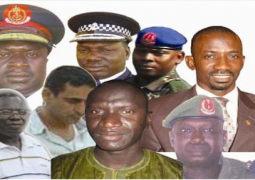
The
sound of the drum can be heard from far away and it is echoing with songs of
freedom as we welcome our new President His Excellency Adama Barrow.
In
our last edition, we talked a little about the drum and its use and importance
in jazz. We also dilated on the structure of the drum and the various
components that make up the drum set. The drum has always been an integral part
of African culture and has served as a medium of communication for people on
the continent and for Africans the world over. It is also closely associated
with jazz music, and together with the piano, they represent the fundamental
instruments on which the music was developed. We have traced how the evolution
of jazz took shape from the Marching Bands, to Big Bands playing swing, to mainstream
jazz and then bebop, post bebop and everything else that came after. What is
important to note here however, is that jazz music originated in the United
States in the 19th century, through the confrontation of blacks with European
music. Jazz differs from European music in that it has a special relationship
to time which is defined as “Swing”. There have been many attempts to define
jazz, but none of it is complete or satisfactory because of its evolving
nature.
While
it may be difficult to define, the art of improvisation is clearly one of its
key elements. Jazz music is a spontaneous and vital musical production in which
improvisation plays an integral role and the sonority and manner of phrasing by
the performing musician is usually a mirror of his or her individuality. It is
music that includes qualities such as, swinging, improvising, and group
interaction, developing an individual voice and being open to different musical
possibilities.It is also the product of egalitarian creativity, interaction and
collaboration, placing equal value on the contribution of the composer and
performer.
In
European classical music, the elements of interpretation, ornamentation and
accompaniment, are at times left to the discretion of the performer whose
primary role is to play a composition as it was written. European classical
music is said to be the composer’s medium, while in jazz, the skilled performer
will interpret a time in a very individual way, never playing the same
composition exactly the same way twice, all depending on his or her mood,
experience, interaction with other musicians and even the audience. The early
structures of blues offer repetitive call and response patterns which is a
common element in African American oral tradition and in New Orleans and
Dixieland jazz, performers often took turns playing the melody while others
improvise counter-melodies. By the time of Swing and the Big Band era, there
was reliance on arranged music that was either written or learned by ear and
memorized, as it was common place that many early jazz performers could not
read music.
Our
feature this week is about someone whose early interest in jazz was influenced
by Marching Bands he watched as a child and became fascinated by the drummers.
His birth name is Elvin Ray Jones. He was born in Pontiac, Michigan on
September 9th 1927. He is an American drummer of the post-bop era who became
fascinated with drums at the age of two, and following this early passion, he
joined his High School Marching Band where he developed the rudiments of
drumming. After leaving high school, he joined the U.S. Army in 1946, was
discharged in 1949 and returned home broke and unemployed. He then borrowed
thirty five dollars from his sister and bought his first drum set. He began his
professional career in 1949 playing at a local club in Detroit called the Grand
River Street Club. In 1955, he auditioned for the Benny Goodman Band, but was
not successful, so he decided to move to New York where there were more
opportunities for jazz sidemen to find work. While in New York, he joined
Charles Mingus band and later released a record called J for Jazz. In 1960,
Jones joined the classic John Coltrane Quartet which also included bassist
Jimmy Garrison and pianist McCoy Tyner. This band is widely considered to have
redefined “Swing” (i.e. the rhythmic feel of jazz) in as much the same way that
Louis Armstrong and Charlie Parker did during the early stages of jazz.
Jones
and Coltrane would often play extended duets together and he stayed with
Coltrane until 1966 when he left the band to give way for the group’s second
drummer-Rashid Ali, who had a multi directional approach to the music as
opposed to the polyrhythmic style of Jones. After leaving Coltrane, he remained
active and led several bands in the 60’s and 70’s, notable among those bands
was a trio formed with saxophonist and multi-instrumentalist Joe Farrell and
bassist Jimmy Garrison with whom Elvin recorded the Blue Note album- “Putting
it Together”. Jones would record extensively for the Blue Note label under his
own name and later with groups that featured prominent musicians as well as up
and coming ones. Other musicians, who made significant contributions to Elvin’s
music, were baritone saxophonist Pepper Adams, tenor saxophonist George Coleman
and trumpeter Lee Morgan.
Jones’s
sense of timing and his dynamic focus on polyrhythms brought the drum set to
the forefront of jazz music. His free flowing style became a major influence on
many leading Rock drummers including Mitch Mitchell and Ginger Baker. Jones
performed and recorded with his own band the Elvin Jones Jazz Machine, whose
line up changed through the years. Sonny fortune and Ravi Coltrane (John
Coltrane’s son) both played saxophone with the Jazz Machine through the 90’s,
performing, recording and touring with Elvin. Jones was known to give free
concerts in Prisons and also gave lessons on music history and drumming. He
died of heart failure in Englewood, New Jersey, on May 18th2004. Together with
Art Blakey and Max Roach, Jones is considered one of the legendary jazz
drummers to date.
This
article is in memory of the late Malando Gassama drummer of the former Super
Eagles Band who also played with the Swedish band ABBA and Jazz great Al Jareau
of the United States.



